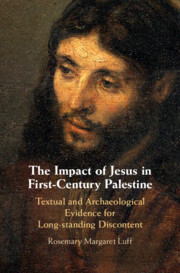 The Impact of Jesus in First-Century Palestine
The Impact of Jesus in First-Century Palestine Book contents
- The Impact of Jesus in First-Century Palestine
- The Impact of Jesus in First-Century Palestine
- Copyright page
- Dedication
- Contents
- Illustrations
- Preface
- Introduction
- Part I Memories of Jesus: The Textual Evidence
- Part II Jesus in Context: The Archaeological Evidence
- 4 Jewish Identities and the Distribution of Ethnic Indicators
- 5 Health Hazards in First-Century Palestine
- 6 Status, Power, and Wealth
- Conclusion
- Bibliography
- Index
6 - Status, Power, and Wealth
from Part II - Jesus in Context: The Archaeological Evidence
Published online by Cambridge University Press: 26 July 2019
- The Impact of Jesus in First-Century Palestine
- The Impact of Jesus in First-Century Palestine
- Copyright page
- Dedication
- Contents
- Illustrations
- Preface
- Introduction
- Part I Memories of Jesus: The Textual Evidence
- Part II Jesus in Context: The Archaeological Evidence
- 4 Jewish Identities and the Distribution of Ethnic Indicators
- 5 Health Hazards in First-Century Palestine
- 6 Status, Power, and Wealth
- Conclusion
- Bibliography
- Index
Summary
In order to pinpoint the centralization of wealth and power in Palestine, this chapter compares and contrasts levels of wealth across Galilee and Judea. There is no longer a clear demarcation between urban and rural settlements in first-century Galilee. Some villages demonstrate urban characteristics reflected by a variety of building styles and house decoration, and this is indicative of a distinct socio-economic hierarchy, with the emergence of an elite espousing Graeco-Roman tastes. In addition to arable and pastoral farming, various industries flourished, some on an industrial scale. The infrastructures of both Sepphoris and Tiberias had scarcely been developed by the early first century, with the houses of the rich at Sepphoris dating to the second century. Taking Magdala aside, which Jesus appeared to avoid as with other Galilean cities, the level of wealth identified in Galilee is far surpassed by that uncovered in Jerusalem, in particular the lavish mansions of the priestly aristocracy in the Upper City. The Upper City priestly quarter and its relationship to the nearby Temple embodies the centralization of wealth and power that Jesus opposed in first-century Palestine.
- Type
- Chapter
- Information
- The Impact of Jesus in First-Century PalestineTextual and Archaeological Evidence for Long-standing Discontent, pp. 145 - 186Publisher: Cambridge University PressPrint publication year: 2019


